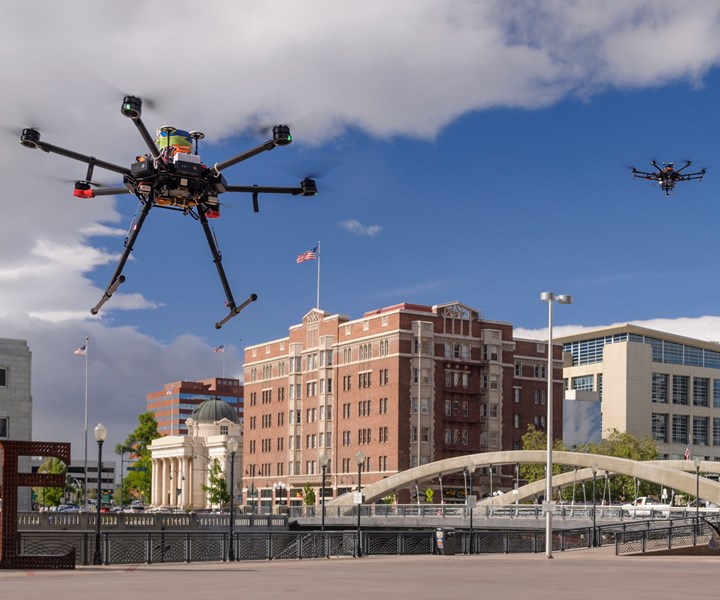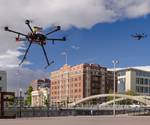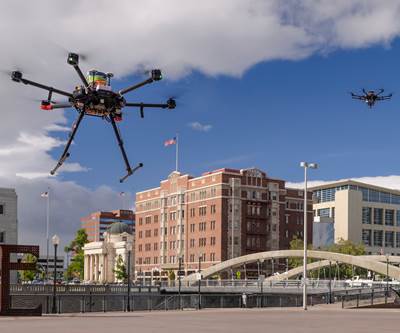Urban air mobility: The action heats up
Columnist Dale Brosius reflects on the current state of the under-development urban air mobility (UAM) market, where it’s headed, and what it all means for the composites industry.

The goal of NASA’s UAM Grand Challenge is to provide a proving ground where NASA, vehicle providers, airspace technology providers, and the public learn what it really requires to achieve urban air mobility. Source | NASA
I’m just back from CAMX, which was replete with exciting innovations, presentations and displays across the spectrum of composites. While at the show I took the pulse of the industry and caught up with hundreds of colleagues and acquaintances acquired over the years. One thing I really like about CAMX is that it goes well beyond the typical format for a trade show and technical conference. Beyond extras like tutorials and workforce development activities, there are numerous opportunities for special interest groups to congregate, and there are a number of side meetings covering specific topics.
A series of these meetings were organized by the American Composites Manufactuers Assn. (ACMA, Arlington, Va., U.S.) under the organization’s Composites Growth Initiative. These committees, largely consisting of industry participants and led by ACMA staff, delve in to ways to increase expansion of composites in markets like automotive, infrastructure, construction and corrosion resistance. Due to other obligations, I was only able to attend two meetings, one on automotive, and the second on a relatively new and exciting topic, urban air mobility (UAM). I had previously written about this topic in September 2018, asking whether there really is a market for flying cars and air taxis, and if a true business case can be made for them. To my surprise, more than 50 people attended the CAMX meeting, and it is clear there is great enthusiasm in the composites community for the potential of this yet-to-be-developed application.
The meeting was organized by ACMA and Danielle McLean of HappyTakeOff, a Wichita-based consultancy focused on the aircraft and infrastructure needs of the UAM market. McLean believes “the need for composites expertise is huge,” not only for airframes, but for lightweight infrastructure that will go atop parking garages and other large-surface-area-buildings to serve as “vertiports.” Dr. Anita Sengupta, chief product officer for Airspace Experience Technologies (ASX), one of many aspiring suppliers of electric vertical take off and landing (eVTOL) vehicles, believes that being based in Detroit enables the company to have an automotive production mindset to keep aircraft costs low (less than $1 million per vehicle) to make the business case work. ASX has tested subscale models and is working toward a full-scale prototype. John Geriguis, with California-based Joby Aviation, noted that his company continues flight testing of full-scale versions of its aircraft and is actively adding staff across multiple disciplines, including composites engineers. Andy Bridge of Janicki Industries (Sedro-Woolley, Wash., U.S.) emphasized that the fabrication volumes for UAM aircraft fall well above the typical 10 per week reference point for aircraft such as the 737 and A320, and well below high-volume automotive of more than 100,000 per annum. A target of 50-100 UAM vehicles per day may be needed to meet demand and amortize fixed costs to be competitive. This falls into the range of production of BMW’s i3, so processes such as high-pressure resin transfer molding (HP-RTM), thermoplastic stamping and pultrusion could play key roles.
And what about the economics? Can flying taxis be profitable and will there be enough demand? Michael Dyment, founder of NEXA Capital Partners (McLean, Va., U.S.) has no doubt. Dyment spoke at the ACMA event and also in a longer session during the conference, noting that by 2050, more than 6 billion people worldwide will live in urban areas, with increasing congestion for people, goods and services. UAM provides a fundamental change in lifestyle, much like the automobile, passenger aircraft, personal computers and mobile telephones have in the past. He notes that there are more than 100 eVTOL manufacturers working to develop, fly and certify aircraft for the UAM market. “There is a market today,” he says. “Just not the infrastructure to support it.” NEXA studied 74 large cities globally, identifying more than 4,000 heliports, most of which need to be repurposed for UAM, to the tune of more than $30 billion. This presents a real opportunity for composites. In the 2020-2040 timeframe, NEXA estimates the UAM market could generate more than $318 billion in revenues with more than $600 billion in total economic impact in the 74 cities studied. The market for air vehicles in this period will exceed $41 billion.
While attendees at the ACMA meeting were optimistic, everyone knows there are still major hurdles to overcome, including standards, how to regulate the airspace and how to certify the aircraft. NASA and the FAA are working together to develop a UAM “Grand Challenge” to address these impediments, with a first phase of developmental flights in late 2020, then full field demonstrations with a small number of participants in 2022. A second, broader grand challenge will follow. If all goes well, within five years, we will see UAM roll out, and open up a sizable market for composites.
Related Content
Plant tour: Joby Aviation, Marina, Calif., U.S.
As the advanced air mobility market begins to take shape, market leader Joby Aviation works to industrialize composites manufacturing for its first-generation, composites-intensive, all-electric air taxi.
Read MoreCollins Aerospace to lead COCOLIH2T project
Project for thermoplastic composite liquid hydrogen tanks aims for two demonstrators and TRL 4 by 2025.
Read MoreComposites opportunities in eVTOLs
As eVTOL OEMs seek to advance program certification, production scale-up and lightweighting, AAM’s penetration into the composites market is moving on an upward trajectory.
Read MoreHonda begins production of 2025 CR-V e:FCEV with Type 4 hydrogen tanks in U.S.
Model includes new technologies produced at Performance Manufacturing Center (PMC) in Marysville, Ohio, which is part of Honda hydrogen business strategy that includes Class 8 trucks.
Read MoreRead Next
NASA announces urban air mobility challenge
NASA’s UAM Grand Challenge will be a full field demonstration in an urban environment to test the readiness of UAM vehicles and airspace operator systems.
Read MorePlant tour: Daher Shap’in TechCenter and composites production plant, Saint-Aignan-de-Grandlieu, France
Co-located R&D and production advance OOA thermosets, thermoplastics, welding, recycling and digital technologies for faster processing and certification of lighter, more sustainable composites.
Read More



















